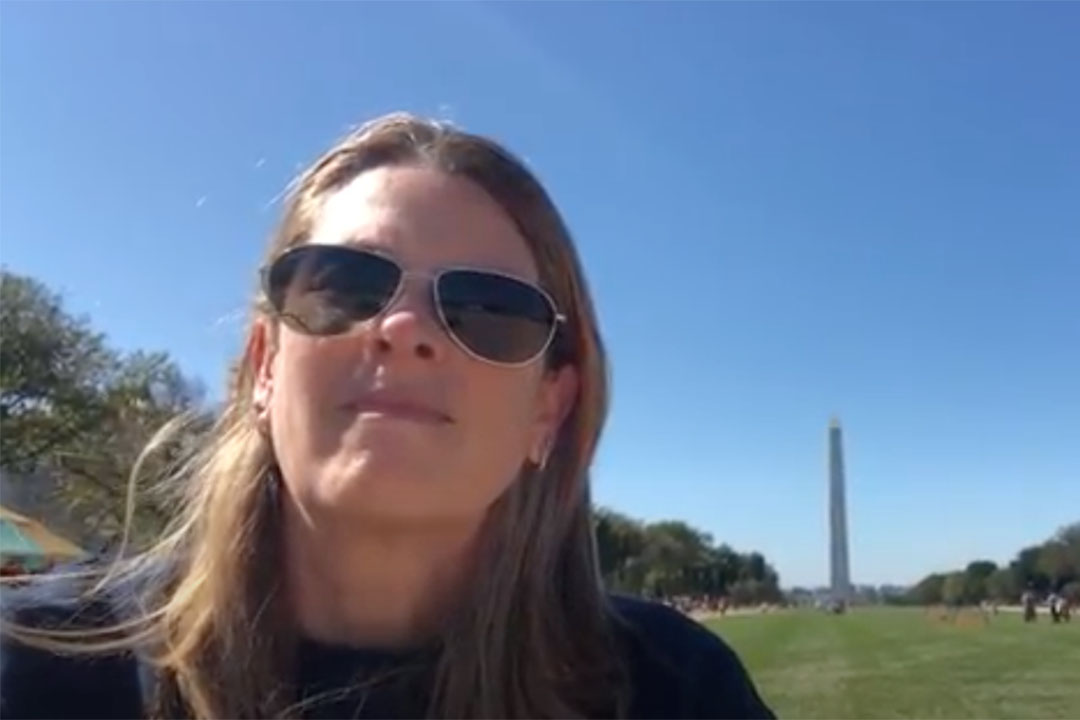Even as they continue adjusting to their own virtual teaching landscapes, four Columbian College faculty members joined a College Board effort to support Advanced Placement (AP) high school students studying remotely during the COVID-19 pandemic.
The faculty—Professor of Geography and Department Chair Lisa Benton-Short; Associate Provost for Special Programs and Professor of Geography and International Affairs Elizabeth Chacko; Associate Professor of Honors and Physics Bethany Cobb Kung; and Associate Professor of History Denver Brunsman—recorded lectures on their specialty topics for the “AP Daily” video series. The 10-to-30 minute videos supplement AP course materials by offering college-level instruction for students and ease burdens on teachers facing a dearth of resources.
“I’m reinventing my curriculum every class—and I only meet my students twice a week,” Kung said. “High school teachers are doing this every single day.”
The free, online videos feature 250 faculty from over 150 institutions across the country. Since the start of the academic year, the lectures have been viewed by more than 8.5 million students through the College Board’s “AP Classroom” portal, with millions more accessing the videos through YouTube, said Cathy Brigham, senior director of higher education academic outreach at the College Board. The videos have a staggered release throughout the school year to follow the pace of AP course instruction.
“We are thrilled to partner with GW to help prepare these students for the opportunities provided by higher education,” Brigham said. “To have such talented professors contributing as AP Daily lecturers is truly a benefit to the students and the entire educational community. As subject matter experts, the GW professors are able to share the depth and breadth of their knowledge with high school students who are up for the challenge.”
CCAS faculty said they were given wide latitude to choose topics that covered subjects and skills on the AP exams. “It was a blend of high school teachers and college faculty working together to produce inspired videos,” said Benton-Short, who was recently appointed AP Human Geography Chief Reader. “And it was a wonderful way to highlight the exciting work that GW faculty are doing in a diverse range of subjects.”
Rather than repeating classroom content, Brunsman, a member of the AP U.S. History Development Committee, said the faculty supplemented the curriculum with “more intellectually broadening” materials. His video on “ Declaring Independence” delved into the American colonists’ slow-building dissatisfaction with British rule. He included forensic digital scans of Thomas Jefferson’s corrections to the Declaration of Independence.
Chacko, who is currently the chair of the College Board’s Advanced Placement Higher Education Advisory Committee, uses a case study of Ethiopian immigrants in the Washington, D.C., area to help students understand the economic, political and environmental factors that cause the outflow of immigrants from some countries and inflow into others, country policies that aid or hinder immigration and the processes of immigrant adjustment. In her video, Chacko uses maps, charts and photographs to highlight the rise of immigration from Ethiopia, especially in the D.C. area. “I wish for students to appreciate the geographical impacts of immigration and immigrants not just at the national level but at the level of cities and neighborhoods,” she said. “Since many students have immigrant ancestors, I also hope that they will understand how immigration is very much a part of the American story.”
For her video on “Energy and Power,” Kung showcased how basic physics principles apply to phenomenon from supernovas to our own sun. “These big issues reach beyond the classroom and into the real world,” she said. “I wanted to show students that they are so exciting that people like me spend our whole careers looking at them.”
In her geography video, which has yet to be released, Benton-Short took viewers on a walking tour of Washington, D.C. With a selfie stick and iPhone, she traced the social significance of sites like the Capitol and Black Lives Matter Plaza. “Geographers go out into the field. We explore places,” she said. “My goal was to convey what I do to students who may never meet a real-life geographer.”

Professor of Geography Lisa Benton-Short toured Washington, D.C., sites like the Washington Monument for her AP Daily video.
The faculty were conscious of the lack of student interaction. “On video, you can't read the room and see how people are reacting to what you’re saying,” Brunsman said. At the same time, many adapted the AP video strategies to their own remote classes, incorporating shorter lectures and more time for exploring subjects in deeper contexts. “It’s made us rethink how we deliver information and how students best absorb it,” Benton-Short said.
With more than 2.6 million public high school students participating in AP exams in 2019-2020—and AP instruction in more than 22,000 high schools across the country—the video series provided a far-reaching forum for faculty to introduce their subjects to college-bound students. And CCAS professors said they were eager to collaborate with high school teachers whose online learning challenges often mirror their own. With her daughter attending elementary school remotely, Kung said she’s seen first-hand how beleaguered teachers are struggling to keep their students engaged through a computer screen. “Both as an educator and a parent, I know how hard K-12 teachers are working right now to support students. This seemed like a way that I could help.”


